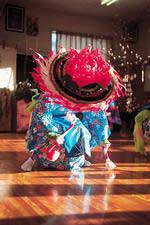
Taro dance of Yamaya
It is a performing arts with the meaning of "Yoshiku" which dances the work of Inada and prays for the good year of the year by doing "thing imitating". Generally, it takes place during the New Year period and is roughly divided into "Niwada planting (dance)" performed outdoors and "Zashikida planting (dance)" performed indoors.
The rice-planting dances in the prefecture are classified into Kesen, Higashi-Kai (Isen), Isawa (Isawa), Waga (Waga), and Chubu (Morioka), etc. A working conductor called "Sonzo," "Samurai Juro," "Enburi", etc., was the facilitator, described the mouth and told the start of the work, with a Saotome (shotomeme) and a stick with a garnish Young people called "Yekko", "Ayatori" dance, and Joka 18 (Ippachi) encourages it. Dances that simulate work such as making nursery, rice planting, harvesting rice, etc. will be danced in order.
In addition to being designated as a major intangible folk cultural property of the country, Shiwa-cho "Yamaya's Tayu Odori" (Yamaya's Tayu Odori) is a Shiwa Town that beautifully turns a flower crown crowned by a Saotome on her head. Only in the prefecture, "Haruta hit" (Harutachi) of Kitakami city which is rare existence nationwide receives designation of intangible folk cultural property of prefecture.
